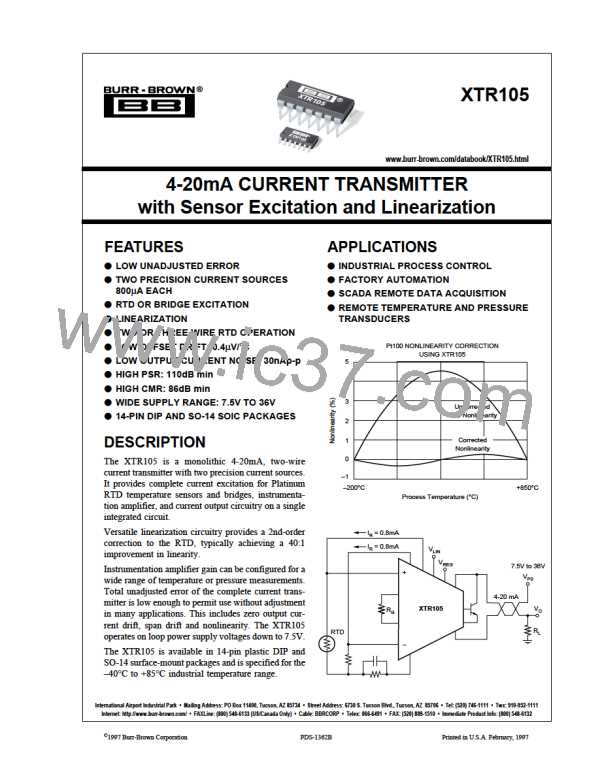The transfer function through the complete instrumentation
amplifier and voltage-to-current converter is:
APPLICATION INFORMATION
Figure 1 shows the basic connection diagram for the XTR105.
The loop power supply, VPS, provides power for all cir-
cuitry. Output loop current is measured as a voltage across
the series load resistor, RL.
IO = 4mA + VIN • (40/RG)
(VIN in volts, RG in ohms)
where VIN is the differential input voltage. As evident from
the transfer function, if no RG is used the gain is zero and the
output is simply the XTR105’s zero current. The value of RG
varies slightly for two-wire RTD and three-wire RTD con-
nections with linearization. RG can be calculated from the
equations given in Figure 1 (two-wire RTD connection) and
Table I (three-wire RTD connection).
Two matched 0.8mA current sources drive the RTD and
zero-setting resistor, RZ. The instrumentation amplifier in-
put of the XTR105 measures the voltage difference between
the RTD and RZ. The value of RZ is chosen to be equal to
the resistance of the RTD at the low-scale (minimum)
measurement temperature. RZ can be adjusted to achieve
4mA output at the minimum measurement temperature to
correct for input offset voltage and reference current mis-
match of the XTR105.
The IRET pin is the return path for all current from the current
sources and VREG. The IRET pin allows any current used in
external circuitry to be sensed by the XTR105 and to be
included in the output current without causing an error.
R
CM provides an additional voltage drop to bias the inputs of
the XTR105 within their common-mode input range. RCM
should be bypassed with a 0.01µF capacitor to minimize
common-mode noise. Resistor RG sets the gain of the instru-
mentation amplifier according to the desired temperature
range. RLIN1 provides second-order linearization correction
to the RTD, typically achieving a 40:1 improvement in
linearity. An additional resistor is required for three-wire
RTD connections, see Figure 3.
The VREG pin provides an on-chip voltage source of approxi-
mately 5.1V and is suitable for powering external input
circuitry (refer to Figure 6). It is a moderately accurate
voltage reference—it is not the same reference used to set
the 800µA current references. VREG is capable of sourcing
approximately 1mA of current. Exceeding 1mA may affect
the 4mA zero output.
IR = 0.8mA
IR = 0.8mA
Possible choices for Q1 (see text).
TYPE
PACKAGE
2N4922
TIP29C
TIP31C
TO-225
TO-220
TO-220
12
1
IR1
7.5V to 36V
VLIN
14
13
11
VI+N
IR2
10
V+
VREG
IO
4
RG
4-20 mA
9
8
R(G2)
B
E
0.01µF
Q1
XTR105
VO
+
3
2
RG
VI–N
(3)
RLIN1
RL
VPS
–
IO
7
IRET
(1)
6
40
RG
RTD
RZ
IO = 4mA + VIN • (
)
NOTES: (1) RZ = RTD resistance at minimum measured temperature.
2R1(R2 +RZ) – 4(R2RZ)
RCM = 1kΩ
(2)
RG
=
R2 – R1
RLIN(R2 – R1)
(3)
0.01µF
RLIN1 =
2(2R1 – R2 – RZ)
where R1 = RTD Resistance at (TMIN + TMAX)/2
R
2 = RTD Resistance at TMAX
RLIN = 1kΩ (Internal)
FIGURE 1. Basic Two-Wire RTD Temperature Measurement Circuit with Linearization.
®
XTR105
7

 BB [ BURR-BROWN CORPORATION ]
BB [ BURR-BROWN CORPORATION ]